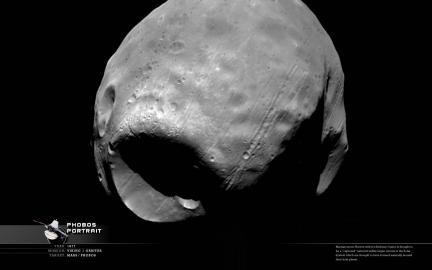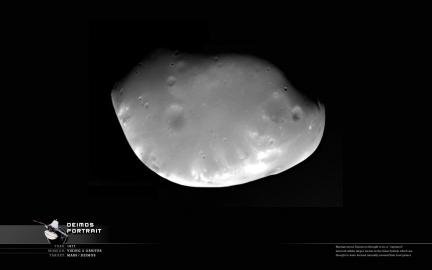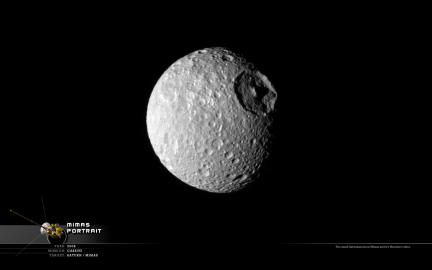Nice update to an old Voyager image with colors added based on actual colors captured in other images. See original post here by Jason Major.
Ganymede Looking Better, Thanks Ted
Another new near global image of Ganymede by Ted Styrk. He has been producing new views of this Galilean moon for a while now from the old Galileo image sets which were compromised by a glitch that effected the entire mission.
WOW
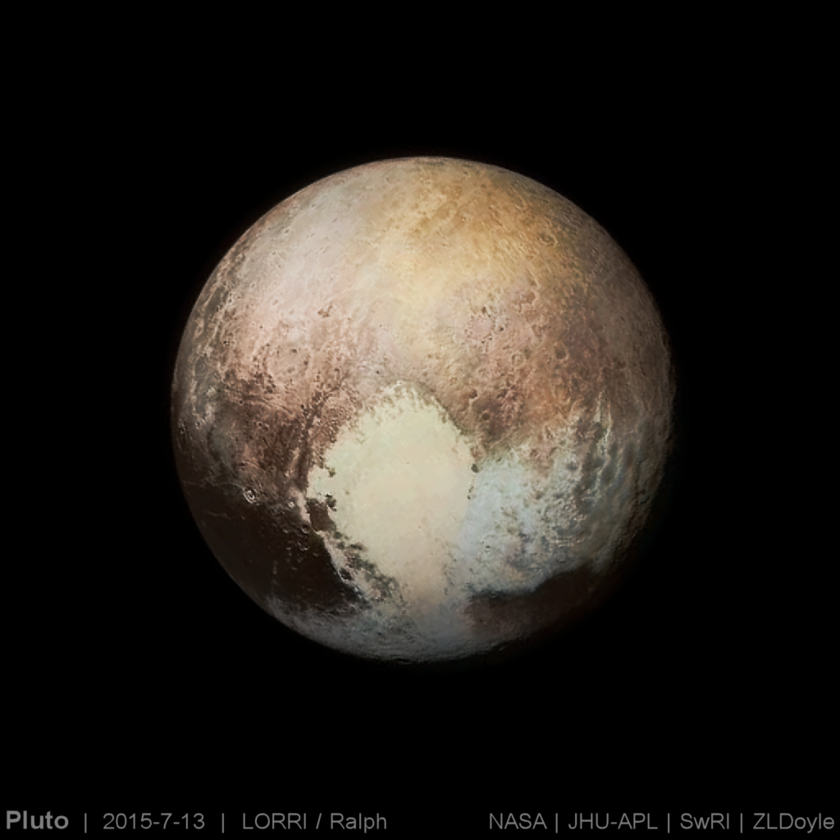 Shown above is an early best guess at Pluto’s actual colors. The “color” image that has saturated all forms of media is actually just a monochrome with the colors seen earlier in the mission laid over it. So that is really just an artificial duotone. Shown above is a gorgeous color image with best-guesses at Pluto’s true colors based upon chemical maps made by New Horizons.
Shown above is an early best guess at Pluto’s actual colors. The “color” image that has saturated all forms of media is actually just a monochrome with the colors seen earlier in the mission laid over it. So that is really just an artificial duotone. Shown above is a gorgeous color image with best-guesses at Pluto’s true colors based upon chemical maps made by New Horizons.
MOM is at Mars
 You know how your Mother will always take the most predictable pictures at the holidays? Well, the Mars Orbiter Mission has done exactly that with it’s recent global image of Mars and it turns out to actually be quite a rare image. Despite so many probes being active at Mars at once, most are too close to the planet to be able to capture a full disc image like this.
You know how your Mother will always take the most predictable pictures at the holidays? Well, the Mars Orbiter Mission has done exactly that with it’s recent global image of Mars and it turns out to actually be quite a rare image. Despite so many probes being active at Mars at once, most are too close to the planet to be able to capture a full disc image like this.
It is also the first interplanetary space mission for the Indian Space Research Organization and is really just a technology demonstrator for the group. This makes India only the fourth space agency to reach Mars and quite an accomplishment to do so successfully on it’s first try. To provide context for that statement, here is a list of missions to Mars and all the ones listed in bold (most spectacularly) failed to reach their goals. So Wanderingspace is happy to welcome another active player to the field of planetary exploration.
Ganymede Looking Better, Thanks Ted
 Another new near global image of Ganymede by Ted Stryk. He has been producing new views of this Galilean moon for a while now from the old Galileo image sets which were compromised by a glitch that effected the entire mission.
Another new near global image of Ganymede by Ted Stryk. He has been producing new views of this Galilean moon for a while now from the old Galileo image sets which were compromised by a glitch that effected the entire mission.
Saturn Portrait Rings Unlit
 We have had our share of global Saturn portraits, but I do believe this is the first taken where the rings are unlit by the sun. An interesting alternate view provided by Gordan Ugarkovic (as usual).
We have had our share of global Saturn portraits, but I do believe this is the first taken where the rings are unlit by the sun. An interesting alternate view provided by Gordan Ugarkovic (as usual).
Wallpaper: Mercury Portrait Updated
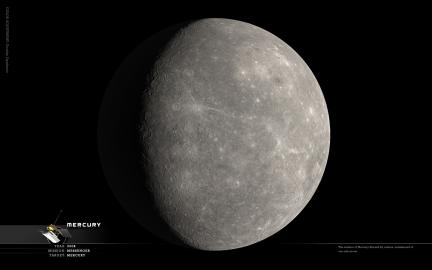 Seemed about time to update the old Mercury “portrait” wallpaper to the new Messenger Mercury “portrait”. It seems possible this color view of Mercury may be replaced again by a better view from the coming October Messenger flyby of Mercury (or perhaps by yet unreleased images from the January flyby), but for now this sure does it.
Seemed about time to update the old Mercury “portrait” wallpaper to the new Messenger Mercury “portrait”. It seems possible this color view of Mercury may be replaced again by a better view from the coming October Messenger flyby of Mercury (or perhaps by yet unreleased images from the January flyby), but for now this sure does it.
NOTE: This is a re-post, the image has been updated with Gordan Ugarkovic’s colors as the official NASA version had a good amounf of false colors which gave many details a blueish hue that would not be visible to human eyes.
Wallpaper 2560x1600 Set 03: The Planets
The planets – the complete set for collectors! While there are literally thousands of images of the planets to choose from… full globe high resolution images are actually fairly rare. They usually require many exposures to be stitched together to make one large complete image. This is not only difficult to work out across the great distances of space, but also soaks up a large amount of valuable spacecraft time and energy. This set represents the best available images of each planet in our Solar System.
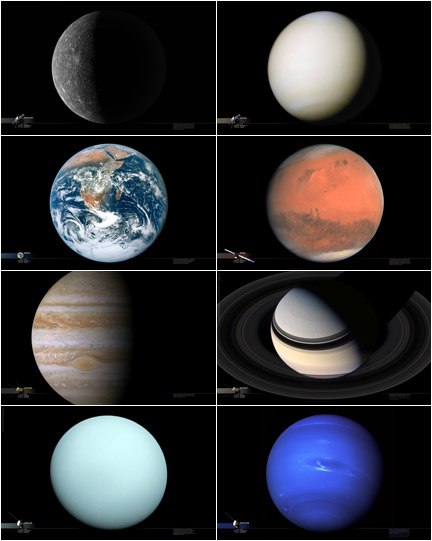
Sorry, no Pluto for more than one reason.
Wallpaper: Iapetus Bright Portrait
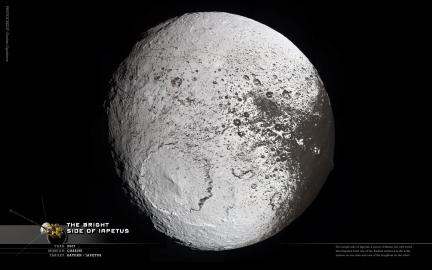 It had to happen… regularly featured on this site Gordan Ugarkovic stitches together an awesome hi-res full globe image of Iapetus only a few days after the closest approach (see previous post for even larger sized wallpaper for bigger monitors). I usually only label an image a “portrait” once for each body, but seeing as Iapetus has two different sides… I think it deserves two. Here is the darker side imaged earlier in 2005.
It had to happen… regularly featured on this site Gordan Ugarkovic stitches together an awesome hi-res full globe image of Iapetus only a few days after the closest approach (see previous post for even larger sized wallpaper for bigger monitors). I usually only label an image a “portrait” once for each body, but seeing as Iapetus has two different sides… I think it deserves two. Here is the darker side imaged earlier in 2005.
Wallpapers: Some of the Minor Moons
Wallpaper: Earth Portrait
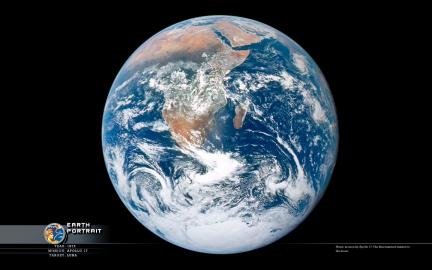 You have probably seen this image of the Earth before. This was the way the Earth appeared to the final astronauts to land on the moon in 1972. It has since become the quintessential Earth portrait, used more often than any other global image of the Earth. This is probably due to its beauty but also worth mentioning the relative rarity with which we get to see a full globe image taken of the Earth in one snapshot. Only missions and probes that leave the vicinity of the Earth are able to do this and some other popular Earth portraits have been taken by Galileo, Messenger… there is the famous Earth/Moon portrait taken by Voyager 1 and of course several from various Apollo missions.
You have probably seen this image of the Earth before. This was the way the Earth appeared to the final astronauts to land on the moon in 1972. It has since become the quintessential Earth portrait, used more often than any other global image of the Earth. This is probably due to its beauty but also worth mentioning the relative rarity with which we get to see a full globe image taken of the Earth in one snapshot. Only missions and probes that leave the vicinity of the Earth are able to do this and some other popular Earth portraits have been taken by Galileo, Messenger… there is the famous Earth/Moon portrait taken by Voyager 1 and of course several from various Apollo missions.
Wallpaper: Phoebe Portrait
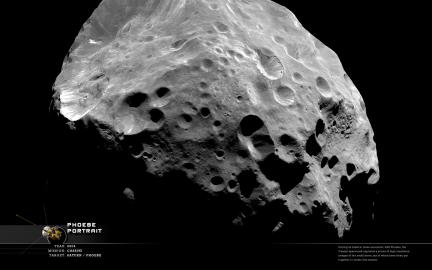 A few posts back I uploaded a closer detail of this same image. This is the best “portrait” image of Phoebe available taken by Cassini on its way into the Saturn system and orbit insertion. Being so far out from the rest of the most dle scientific targets (4x as far as Iapetus), this was the only up-close visit planned to the tiny moon who’s size is about 220km average width.
A few posts back I uploaded a closer detail of this same image. This is the best “portrait” image of Phoebe available taken by Cassini on its way into the Saturn system and orbit insertion. Being so far out from the rest of the most dle scientific targets (4x as far as Iapetus), this was the only up-close visit planned to the tiny moon who’s size is about 220km average width.
Wallpaper: Ariel Portrait
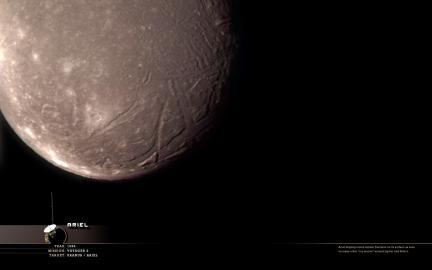 Ariel is the third of the five larger moons or Uranus. It is somewhat similar to Saturn’s Rhea in composition, about 30% rock and 70% ices. There are obvious ridges and details that would appear to be somewhat “young” features (which is still quite old to you and me), but there is little known about this moon as it was only viewed once from 127,000 km by Voyager 2.
Ariel is the third of the five larger moons or Uranus. It is somewhat similar to Saturn’s Rhea in composition, about 30% rock and 70% ices. There are obvious ridges and details that would appear to be somewhat “young” features (which is still quite old to you and me), but there is little known about this moon as it was only viewed once from 127,000 km by Voyager 2.
Wallpaper: Europa Portrait Render
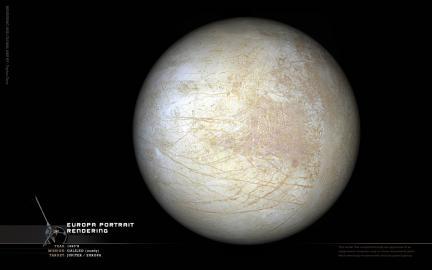 The previous Europa portrait posted here, is the most commonly seen image of the full globe of Europa. Even though there have been multiple missions to Jupiter and its system of moons (including an orbiter which stuck around for quite a while)… there are surprisingly few full globe images of Europa. The one used in the previous post mentioned was compiled through several filters but due to some incomplete data, an artificial green haze appears at the right edge of the disc. Considering the scientific importance of Europa and its unique appearance makes a full globe view of this world highly desirable in my mind.
The previous Europa portrait posted here, is the most commonly seen image of the full globe of Europa. Even though there have been multiple missions to Jupiter and its system of moons (including an orbiter which stuck around for quite a while)… there are surprisingly few full globe images of Europa. The one used in the previous post mentioned was compiled through several filters but due to some incomplete data, an artificial green haze appears at the right edge of the disc. Considering the scientific importance of Europa and its unique appearance makes a full globe view of this world highly desirable in my mind.
Enter Tayfun Öner who is the author of the above render. This model was created by stitching together a map of the Europan surface from a multitude of images. At this point in history, a good amount of Europa has been photographed and allows one to make an almost complete surface map as seen below. The clearest and best resolved regions of the map are likely from the Galileo mission and where gaps appeared from that mission the spaces were filled in with images taken by Voyager. 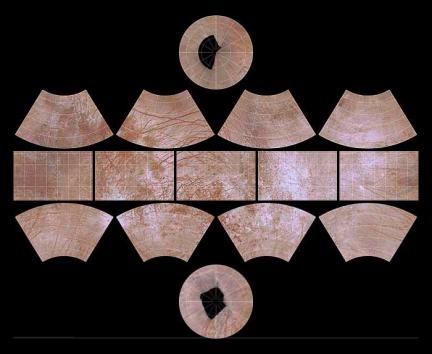 I usually prefer straight photography for the puposes of this site, but this is one of the most impressive renders I have ever seen of any body in the solar system. Seeing as how data sets for full global images of Europa are flawed at best… this render does the job most impressively. The full hi-res set of Europa maps by Tayfun can be found here for the curious.
I usually prefer straight photography for the puposes of this site, but this is one of the most impressive renders I have ever seen of any body in the solar system. Seeing as how data sets for full global images of Europa are flawed at best… this render does the job most impressively. The full hi-res set of Europa maps by Tayfun can be found here for the curious.
Wallpaper: Rhea Portrait
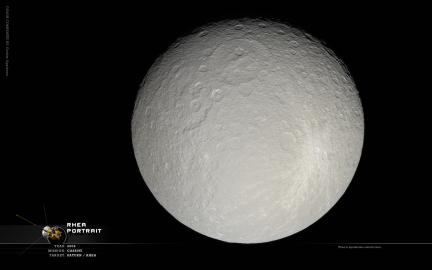 Rhea is the second largest of Saturn’s moons but lacks any of the exciting features of some of the others. It has some of the “wispy” features that have been determined to be ice cliffs on Dione, but they are far less prominent here. Just another big ball of water ice for future earth visitors to mine for resources!
Rhea is the second largest of Saturn’s moons but lacks any of the exciting features of some of the others. It has some of the “wispy” features that have been determined to be ice cliffs on Dione, but they are far less prominent here. Just another big ball of water ice for future earth visitors to mine for resources!
Wallpaper: Tethys Portrait
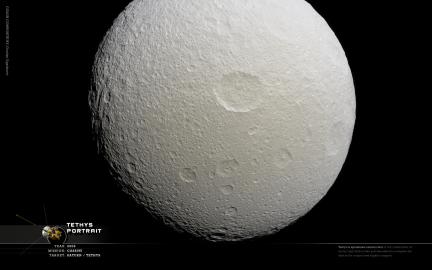 One of the mid-sized moons of Saturn, Tethys, is thought to be composed almost entirely of water ice. Its most remarkable features are Odysseus, a 400 km wide crater and the Ithaca Chasma a 2,000 km long valley that runs across 2/3 of Tethy‘s globe. Those features are not visible in this image, but what is visible is the slight color variation which almost appears as a “dusting” of color on a largely grey body. A curious feature especially considering the radical color variation found at Iapetus. Perhaps this discoloring is a more subtle result of the same event which caused the strange color variation on Iapetus?
One of the mid-sized moons of Saturn, Tethys, is thought to be composed almost entirely of water ice. Its most remarkable features are Odysseus, a 400 km wide crater and the Ithaca Chasma a 2,000 km long valley that runs across 2/3 of Tethy‘s globe. Those features are not visible in this image, but what is visible is the slight color variation which almost appears as a “dusting” of color on a largely grey body. A curious feature especially considering the radical color variation found at Iapetus. Perhaps this discoloring is a more subtle result of the same event which caused the strange color variation on Iapetus?
Wallpaper: Dione Portrait
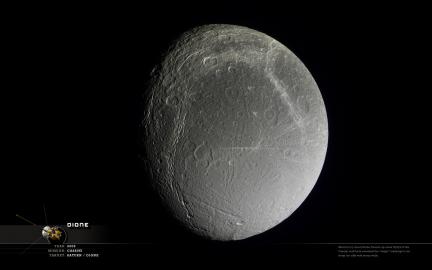 Saturn’s moon Dione seen at almost full disk. Recently the “wispy” markings have been revealed to be giant ice cliffs as seen by the Cassini spacecraft after coming close to 500km from the surface. The cliffs reach as high as several hundred meters high and are thought to be the result of ancient tectonic fractures.
Saturn’s moon Dione seen at almost full disk. Recently the “wispy” markings have been revealed to be giant ice cliffs as seen by the Cassini spacecraft after coming close to 500km from the surface. The cliffs reach as high as several hundred meters high and are thought to be the result of ancient tectonic fractures.
Wallpaper: Iapetus Portrait
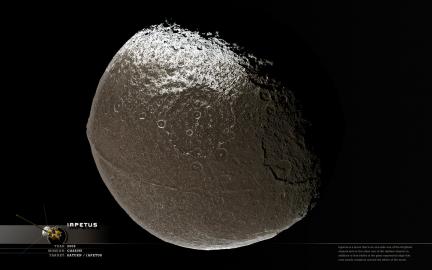 Iapetus is a moon that is on one side one of the brightest objects and on the other one of the darkest objects. In addition to this oddity is the giant equatorial ridge that runs nearly complete around the whole of the moon. Neither of these features origins have been established, although many theories exist. One theory is that Iapetus at one time grazed the edge of Saturn’s rings which would have deposited a huge amount of material around its equator. But to do this it would have had to have been much closer to Saturn and have been ejected out past most of the larger moons to its present position. Another theory suggests that the materials might have come from another of Saturn’s moons, Pheobe, and spiraled in to be swept up by Iapetus. More theories involve internal heating and the movement of matrials from the interior to the surface through various means such as cryo-volcanism.
Iapetus is a moon that is on one side one of the brightest objects and on the other one of the darkest objects. In addition to this oddity is the giant equatorial ridge that runs nearly complete around the whole of the moon. Neither of these features origins have been established, although many theories exist. One theory is that Iapetus at one time grazed the edge of Saturn’s rings which would have deposited a huge amount of material around its equator. But to do this it would have had to have been much closer to Saturn and have been ejected out past most of the larger moons to its present position. Another theory suggests that the materials might have come from another of Saturn’s moons, Pheobe, and spiraled in to be swept up by Iapetus. More theories involve internal heating and the movement of matrials from the interior to the surface through various means such as cryo-volcanism.
IMAGE NOTE: The image was originally black and white and has been colorized based upon other colored images.
Also see the wallpaper of Iapetus’s brighter side here added in September, 2007.
Wallpaper: Hyperion Portrait
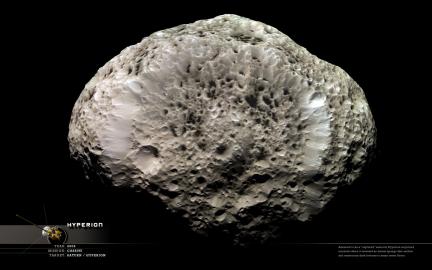 Hyperion is an irregularly shaped moon and like most of these was thought to be a “captured” moon of Saturn, which is an object that strays too close to a larger body and is pulled into its orbit. Soon other theories suggested that perhaps it was a single fragment of some larger body which was largely destroyed and perhaps is what littered Iapetus with its darker material. Now, closer observations show us that much of Hyperion’s interior is hollow space… or nothing… which could mean that Hyperion is actually a collection of smaller fragments of ice and some rock which over time pulled itself together to form Hyperion. In other words an orbiting pile of rubble.
Hyperion is an irregularly shaped moon and like most of these was thought to be a “captured” moon of Saturn, which is an object that strays too close to a larger body and is pulled into its orbit. Soon other theories suggested that perhaps it was a single fragment of some larger body which was largely destroyed and perhaps is what littered Iapetus with its darker material. Now, closer observations show us that much of Hyperion’s interior is hollow space… or nothing… which could mean that Hyperion is actually a collection of smaller fragments of ice and some rock which over time pulled itself together to form Hyperion. In other words an orbiting pile of rubble.
Wallpaper: Miranda Portrait
 Of the five moons of Uranus, the only one to really stand out would be Miranda. One look at the moon suggests that some kind of cataclysmic event must have taken place in its past - huge fault canyons and ridges run across its surface. However, newer theories have replaced the idea that Miranda was shattered several times and instead suggest that somehow internal heating has caused lighter materials to rise up in various locations to the surface. Internal heating in smaller objects (Miranda is about 470km wide) is no longer an unexpected thing in the outer solar system. If it is ever confirmed that Miranda does in fact experience internal heating it will join Enceladus, Io and Europa (and possibly others) in this whole new class of body to be explored in the Solar System.
Of the five moons of Uranus, the only one to really stand out would be Miranda. One look at the moon suggests that some kind of cataclysmic event must have taken place in its past - huge fault canyons and ridges run across its surface. However, newer theories have replaced the idea that Miranda was shattered several times and instead suggest that somehow internal heating has caused lighter materials to rise up in various locations to the surface. Internal heating in smaller objects (Miranda is about 470km wide) is no longer an unexpected thing in the outer solar system. If it is ever confirmed that Miranda does in fact experience internal heating it will join Enceladus, Io and Europa (and possibly others) in this whole new class of body to be explored in the Solar System.



